Managing Well-Being in the Virtual Workplace
By Jaya Koilpillai Bohlmann, M.A., APR
May 2020
The COVID-19 crisis has forced millions of Americans to start working from home this spring.
Even before people found themselves setting up home offices, the increasing universality of other communication technologies was contributing to the rapid increase in remote workers, who are part of flexible work structures provided by employers eager to meet employees’ needs and boost productivity.
However, the benefit has a downside: Remote employees, separated by distance, increasingly feel disconnected from their co-workers, bosses and the overall workplace community.
This disconnection is problematic because being engaged at work and feelings of belonging, safety, community and friendship are critical to workplace well-being.
Engagement has been suffering in U.S. workplaces overall. Less than one-third of U.S. employees have been engaged at their jobs and workplaces since Gallup Daily Tracking began monitoring engagement in the year 2000. Worldwide, workplace engagement is only 12 percent.
Managers can help address their communication needs by employing the following tactics:
• Assign each individual a mentor. A supervisor, manager, peer or someone outside their department can serve as a mentor to help the employee with their engagement and inclusion.
• Communicate in ways that are effective for the employee. This step is especially important when managing cultural or generational differences. For instance, baby boomers might be more open to email newsletters or Facebook while Gen X and millennials likely will respond best to texts, video or other social media.
Also, people who value hierarchy and respect for authority will respond better with in-person communication or messages from executives.
• Instill a culture of kindness and listening. Everyone can be a well-being ambassador by inviting a new employee, who might be sitting alone in the cafeteria, to join their lunch group, or by checking on someone whom they notice rarely leaves the office.
• Build live real-world communities. Groups that encourage positive coworker relationships can include employee resource teams based on interests and hobbies as well as work-related projects.
• Find and build your organization’s version of the old-school water cooler. This hangout is the organic place — real or virtual — where employees can gather. For this, companies use messaging programs like Google Hangout, Microsoft Teams and Slack as well as video services like Skype or Zoom.
Create some structure by planning meetings every quarter or so, and let employees hold their chats in between as they wish.
• Use water-cooler technology to your advantage. Be sure to include virtual workers in your on-site meetings (where most of the other team members gather in person), and make sure you’re effectively engaging with them during these meetings.
Virtual happy hours have also become popular for suddenly homebound employees in recent weeks. Aside from the bonding experience, you may learn something new about your co-workers.
“You see if someone is maybe a gardener, or has three cats, or their kids are riding bikes in the background with their helmets on,” Limeade CEO Henry Albrecht recently told Chief Executive magazine. “You get all those little insights into someone’s life if you’re willing to be open and not so buttoned up.”
And once you are back in the office, remember to bring in your remote workers for in-person meetings and social outings as often as possible to help them feel connected and bond with their co-workers.
Don’t rely on your intranet or software product of choice to serve as the default employee connector. Most employees find it difficult to connect to and navigate even the best-designed, most cutting-edge intranets and choose to get their information and engagement elsewhere. Know what works for your employees.
photo credit: good studio



